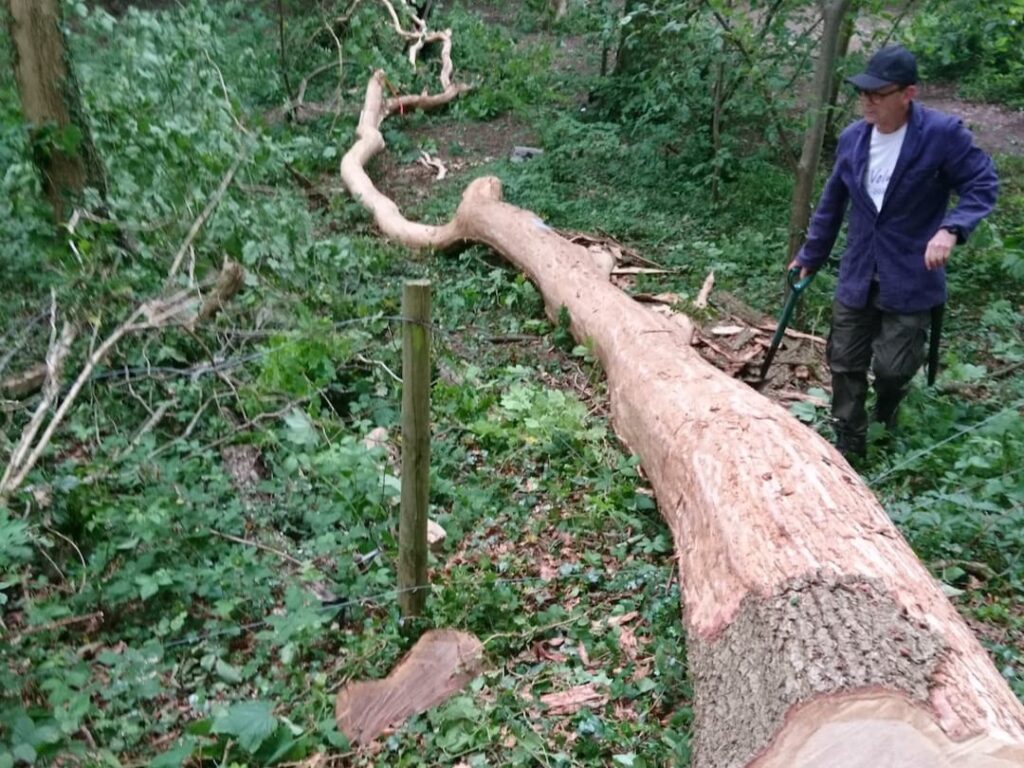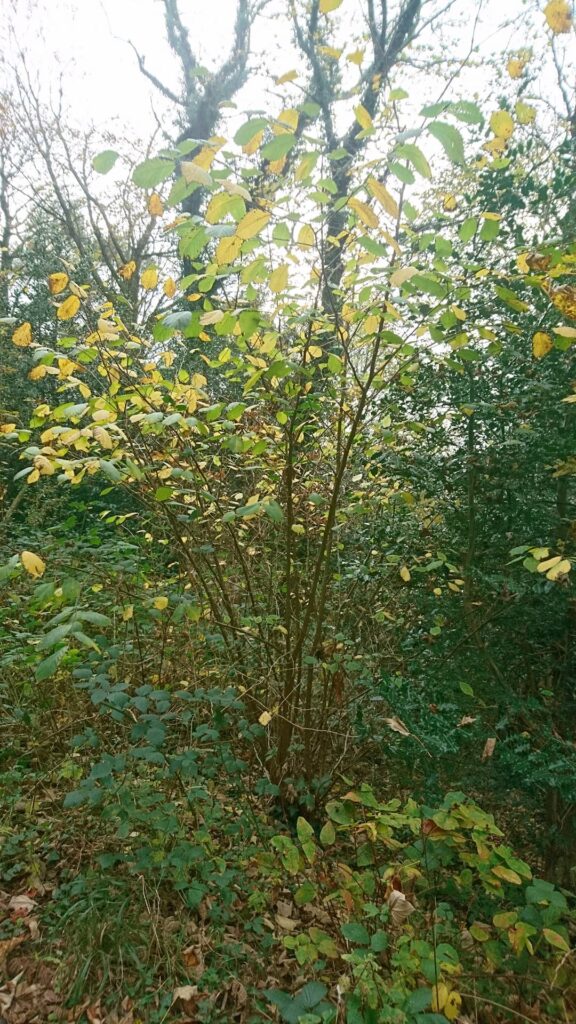Village Information
Oak Bark Peeling
Steeped in centuries-old tradition, oak bark peeling has long been integral to the art of traditional leather production. This article explores Brian Crawley's dedicated journey in preserving this heritage and his ongoing work with the Thwaite Brow Woods Conservation Group.
The Process
To enable the bark to be peeled using special blunt scrapers—a bit like peeling oranges or bananas—trees have to be felled in the spring when the sap is running most strongly between the bark and the wood. This increased sap flow allows the bark to be released more easily.

Felled tree nearly fully peeled
The bark is peeled into approx 2 feet lengths and then tied in bundles for collection. The bark contains tannins—natural substances that are essential for turning animal hides into leather. Tannins help preserve the hides, making the leather strong and durable for years to come. Because of these valuable tannins, oak bark has been a crucial material for leather production.

Oak bark from the wood
For centuries, tanneries across the country have relied on oak bark to produce high-quality leather. It is said that the Bolton-le-Sands tannery was located on the site of the current Co-op. These days, J & F J Baker’s tannery in Devon is reputed to be the last tannery in Great Britain to make leather from oak bark, continuing this traditional craft.

Oak bark going to tannery
Coppicing and Conservation
Our first delivery of oak bark to the tannery in Devon was in 1996. My wife and I had just embarked on a new career in coppice working, a traditional method of woodland management where trees are periodically cut down to near ground level, encouraging them to regrow from the stumps. This practice promotes biodiversity by allowing sunlight to reach the forest floor, fostering a rich variety of plant and animal life and enhancing the overall health of the woodland ecosystem.

Coppice regrowth from cut stump
During this time we were fortunate to learn the art of bark peeling from Bill Hogarth. Bill, who had recently been awarded an MBE for his lifetime dedication to coppicing, often managed to peel between 3 to 6 tons of oak bark each year—it was his favourite activity. Although we never reached those quantities, our bark was taken to Bill’s workbase, from where it was collected for the tannery by Brian and Kay Churchill.
Bill sadly passed away in 1999, and I took on coordinating the collection of the bark each year from the several peelers in South Cumbria and North Lancashire who were taking on the job. Some were apprentices learning coppicing from The Bill Hogarth MBE Memorial Apprenticeship Trust (BHMAT), set up in his name. Brian and Kay stayed overnight with us a few times, but being farming people, they mostly stayed with our daughter on the farm in the Lyth Valley.
My wife and I retired in 2008 but kept our connection with coppicing through the Coppice Association North West (CANW) and the wood in South Cumbria, where we worked as contractors to the Woodland Trust. The South Cumbria wood was subsequently leased to the BHMAT to continue its coppice management.
After moving home to Bolton-le-Sands in 2012, we got involved with the conservation work in Thwaite Brow Woods, which led to the felling of some dangerous leaning oak trees—perfect for peeling! The supply of bark from Thwaite Brow Woods to the tannery in Devon also adds to the Parish Council funds each year.
The History of “Barking”
Robert Swain, a fellow member of the Conservation Group who passed away recently, enjoyed learning to peel bark. As a keen historian, he had learned that in the past, when bark peeling for local tanneries was prolific, young children would help their parents in the woods during the short period each year when this could be done, and the local school records listed their absence as “barking.” This explains its use as the last word on the plaque for Robert’s bench in the woods, which was made from the branch wood of the oak tree felled earlier in the year. The surnames Barker and Tanner have obvious derivations.
Creating Rustic Furniture
The peeled oak trunk and branches are a valuable by-product of the peeling operation. The branches are excellent material for producing rustic furniture like benches and rose arches, which I have continued to make. Through my connections with CANW and BHMAT, I have a customer for the oak trunks. One of these trunks was used by a worker in Grange who produced items for a garden at the Chelsea Flower Show, which went on to win an award.

Bird table from peeled oak
Looking to the Future
Next year may be different, as we have yet to select a suitable oak tree in the wood. There’s also a new tannery starting up in the Cotswolds, which is looking for suppliers of oak bark. This could present new opportunities for our community, and we look forward to seeing how it develops.
Get Involved in Conservation
If you’re interested in supporting our local woodlands or learning more about traditional coppice working, there are many ways to get involved. You can join us for conservation workdays in Thwaite Brow Woods, where you can experience first-hand the rewarding process of bark peeling and woodland management. The Coppice Association North West (CANW) and the Bill Hogarth MBE Memorial Apprenticeship Trust (BHMAT) also welcome volunteers and provide opportunities to learn traditional skills.
Whether you’d like to help maintain our beautiful woodlands, learn a new craft, or enjoy a walk in Thwaite Brow Woods, we encourage everyone to be a part of preserving our local heritage.
—Brian Crawley
President of Coppice Association North West (CANW)